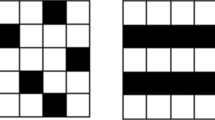Abstract
In this paper, we present a spatio-temporal post-processing error concealment (EC) algorithm designed initially for a H.264 video-streaming scheme over packet-lossy networks. It aims at optimizing the subjective quality of the restored video under the constraints of low delay and computational complexity, which are critical to real-time applications and portable devices having limited resources. Specifically, it takes into consideration the physical property of motion field in order to achieve more meaningful perceptual video quality, in addition to the improved objective PSNR. Further, a simple bilinear spatial interpolation approach is combined with the improved boundary-match (B-M) based temporal EC approach according to texture and motion activity analysis. Finally, we propose a low complexity temporal EC method based on motion vector interpolation as a replacement of the B-M based approach in the scheme under low-computation requirement, or as a complement to further improve the scheme’s performance in applications having enough computation resources. Extensive experiments demonstrated that the proposal features not only better reconstruction, objectively and subjectively, than JM benchmark, but also robustness to different video sequences.
Similar content being viewed by others
References
Alkachouch, Z., Bellanger, M.G., 2000. DCT-based spatial domain interpolation of blocks in images. IEEE Trans. on Image Processing, 9(4):729–732. [doi:10.1109/83.841948]
Chen, M.J., Chen, L.G., Weng, R.M., 1997. Error concealment of lost motion vectors with overlapped motion compensation. IEEE Trans. Circuits and Systems for Video Technology, 7(3):560–563. [doi:10.1109/76.585936]
Joint Video Team (JVT) of ISO/IEC MPEG & ITU-T VCEG, 2003. Draft ITU-T Recomm. and Final Draft Int’l. Standard of Joint Video Specification (ITU-T Rec. H.264 | ISO/IEC 14496-10 AVC), Doc.G050rl.
Kwok, W., Sun, H., 1993. Multidirectional interpolation for spatial error concealment. IEEE Trans. on Consumer Electronics, 39(3):455–460. [doi:10.1109/30.234620]
Mualla, M.A., Canagarajah, C.N., Bull, D.R., 2000. Motion field interpolation for temporal error concealment. IEEE Proc. Visual Image Signal Processing, 147(5):445–453.
Salama, P., Shroff, N.B., Coyle, E.J., Delp, E.J., 1995. Error Concealment Techniques for Encoded Video Streams. Pro. Int. Conf. Image Processing, p.9–12.
Salama, P., Schroff, N.B., Delp, E.J., 2000. Error concealment in MPEG video streams over ATM networks. IEEE J. on Select. Areas in Communication, 18(6):1129–1144. [doi:10.1109/49.848263]
Shirani, S., Kossentini, F., Ward, R., 2000. A concealment method for video communication in an error-prone environment. IEEE J. Select. Areas Commun., 18(6):1122–1128. [doi:10.1109/49.848261]
Sun, H., Kwok, W., 1995. Concealment of damaged block transform coded images using projections onto convex sets. IEEE Trans. on Image Processing, 4(4):470–479. [doi:10.1109/83.370675]
Tsekeridou, S., Pitas, I., 2000. MPEG-2 error concealment based on block-matching principles. IEEE Trans. Circuits and Systems for Video Tech., 10(4):646–658. [doi:10.1109/76.845010]
VCEG, 1999. Internet Error Patterns VCEG-O38rl.doc. ftp://ftp.imtc-files.org/jvt-experts/9910_Red/Q15-I16rl.zip.
Wang, Y., Ostermann, J., Zhang, Y.Q., 2002a. Two-dimensional Motion Models. Video Processing and Communications, Section 5.5. Prentice Hall.
Wang, Y.K., Hannuksela, M.M., Varsa, V., Hourunranta, A., Gabbouj, M., 2002b. The error concealment feature in the H.26L test model. Proc. Int. Conf. Image Processing, 2:729–732.
Wang, Z., Sheikh, H.R., Bovik, A.C., 2003. Objective Video Quality Assessment. In: Furht, B., Marqure, O. (Eds.), Handbook of Video Databases: Design and Applications. CRC Press, p.1041–1078.
Wenger, S., 2003. H.264/AVC over IP. IEEE Trans. on Circuits and Systems for Video Tech., 13(7):645–656. [doi:10.1109/TCSVT.2003.814966]
Zheng, J.H., Chau, L.P., 2003. A motion vector recovery algorithm for digital video using Lagrangian interpolation. IEEE Trans. Broadcasting, 49(4):383–389. [doi:10.1109/TBC.2003.819050]
Author information
Authors and Affiliations
Additional information
Project supported by the Teaching and Research Award Program for Outstanding Young Professor in High Education Institute, Ministration of Education, China
Rights and permissions
About this article
Cite this article
Liao, N., Yan, D., Quan, Zy. et al. Content-adaptive robust error concealment for packet-lossy H.264 video streaming. J. Zhejiang Univ. - Sci. A 7 (Suppl 1), 41–47 (2006). https://doi.org/10.1631/jzus.2006.AS0041
Received:
Accepted:
Published:
Issue Date:
DOI: https://doi.org/10.1631/jzus.2006.AS0041




